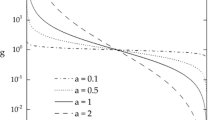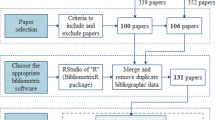Abstract
Stationary distributions, i.e. distributions involving no time dependence, are analysed. The rank and frequency forms of statistical distributions are considered. On the basis of this consideration the approximations of stationary scientometric distributions are reviewed.
Similar content being viewed by others
Explore related subjects
Discover the latest articles and news from researchers in related subjects, suggested using machine learning.Notes and Refernces
H. S. SICHEL, On a Distribution Law for Word Frequencies.J. of the Amer. Statistical Association 70 (1975) 352 part 1 542–547; J. H. HUBERT. Bibliometric Models for Journal Productivity,Social Indicators Research 4 (1977) 441–473; J. K. RAVICHANDRA RAO. The Distribution of Scientific Productivity and Social Change,J. of the Amer. Soc. for Inform. Science 31 (1980) 111–122.
J. VLACHY, Frequency Distribution of Scientific Performance. A Bibliography of Lotka's Law and Related Phenomena. —Scientometrics 1 (1978) 109–131.
J. B. ESTOUP.Gamma Stenographique (4th. ed.), Paris, 1916.
G. K. ZIPF.Psycho-Biology of Language, Haughton Muffin, 1935.
G. K. ZIPF,Human Behaviour and the Principle of Least Effort, adisson Wesley, Cambridge (Mass.), 1949.
G. SCARROTT, Will Zipf join Gauss? —New Scientist 62 (1974) 402–404.
J. C. WILLIS,Age and Area. Univ. Press, Cambridge, 1922.
A. J. LOTKA, The Frequency Distribution of Scientific Productivity,J. of Washington Academy of Sciences 16 (1926) 317–323.
S. C. BRADFORD. Sources of Information on Scientific Subjects, Engineering 26 (1934) January; S. C. BRADFORD.Documentation, Grosby Lookwood and Son LTD, London, 1948.
R. A. FAIRTHORNE. Algebraic Representation of Storage and Retrieval Language.Proceeding of the International Conference on Scientific Information, National Academy of Sciences, Wash., DC., 1958.
M. G. KENDALL, The Bibliography of Operational Research,Operational Research Quarterly 11 (1960) 31–36.
B. C. BROOKES, The Derivation and Application of the Bradford-Zipf Distribution. —J. of Documentation 24 (1968) 247–265.
P. F. COLE, A New Look at Reference Scattering,J. of Documentation 18 (1962) 58–64.
F. F. LAIMKUHLER. The Bradford Distribution,J. of Documentation 23 (1967) 197–207.
S. NARANAN. Power Law Relation in Science Bibliography: a Selfconsistent Interpretation,J. of Documentation 27 (1971) 83–97.
J. BOOKSTEIN. The Bibliometric Distributions,Library Quarterly 46 (1976) 416–423.
See: J. J. HUBERT,op cit., note 1. (1977) 441–473
B. MANDELBROT. Contribution a la theorie mathematique des jeux de communication. Ph. D. Thesis, Paris, Dec, 16, 1952, Publ. de l'Inst. de Statistique de l'Univ. de Paris, Vol. 2, No. 1. 2. p. 80–102, 1953.
A. I. YABLONSKY, Stokhasticheskiye modeli nauchnoy deyatelnosti (Stochastic models of research activities). — In:Sistemniye issledovaniya. Yezhegodnik — 1975 (System Research Yearbook — 1975), Nauka, Moscow, 1976, p. 5–42; A. I. YABLONSKY. On fundamental Regularities of the Distribution of Scientific Productivity,Scientometrics 2 (1980) 3–34.
M. G. KENDALL, Natural Law in the Social Sciences,J. of the Royal Statistical Society 124 (1961) 4–16.
R. A. FAIRTHORNE. Empirical Hyperbolic Distribution (Bradford-Zipf-Mandelbrot) for Bibliometric Description and Prediction,J. of Documentation 25 (1969) 319–349.
A. I. YABLONSKY,op. cit., note 19..
D. J. de S. PRICE. Networks on Scientific Papers,Science 149 (1965) No. 3683, 520–525.
A. PLATZ. Psychology of the Scientist: Lotka's Law and Research Visibility,Psychological Reports 16 (1965) 566–568.
S. NARANAN.op. cit. note 15.
A. I. YABLONSKY.op. cit., note 19.
S. D. HAITUN. Chto takoye “tsitat-indeks” (What is the Citation Index”?Priroda (1980) No. 3, 40–51.
V. PARETO. Course d'economic politique, Paris, 1897.
F. A. HAIGHT. Some Statistical Problems in Connection with Word Association Data.J. of Mathematical Psychology 3 (1966) 217–233.
L. S. KOZACHKOV, L. A. KHURSIN. Ob osnovnom veroyatnostnom raspredeleniyi naukovedeniya (On the Main Probability Distribution in Science of Science), In:Analiz zakonomernostey i prognpzirovaniye razvitiya nauki i tekhniki (Trend Analysis and Technological Forecasting), Vol. 1, Kiev, 1967, p. 42–45.
M. K. BUCKLAND, A. HINDLE. Library Zipf (Letter),J. of Documentation 25 (1969) 154.
B. C. BROOKES. Bradford's Law and the Bibliography of Science,Nature 224 (1969) 953–956.
A. T. MITSEVICH. Issledovaniya structury nauchno-tekhnicheskoy informatsiyi po mashinostroyeniyu (Dissemination of Publications),Nauchno-tekhnicheskaya Informatsiya, Ser. 2 (1975) No. 5, p. 5–16.
C. H. BOSANQUET, Distribution of Word Frequencies. —Nature 179 (1957) 596.
D. J. de S. PRICE,Little Science, Big Science, Columbia Univ. Press, New-York-London, 1963.
H. T. DAVIS,The Analysis of Economic Time Series, The Principla Press Inc. Bloomington, Indiana, 1941, XIV.
G. U. YULE, A Mathematical Theory of Evolution Based on Conclusions of J. C. WILLIS,Phylosophical Transaction of the Royal Society Ser. B, 213 (1924) 21–87.
H. A. SIMON. On a Class of Skew Distribution Function,Biometrica 42 (1955) 425–440.
J. D. de S. PRICE, A General Theory of Bibliometric and Other Cumulative Advantage Processes,J. of the Amer. Soc. for Inform. Science 27 (1967) 292–306.
M. G. KENDALL.op. cit., note 11..
J. O. IRWIN. The Generalized Wording Dsitribution Applied to Accident Theory,J. of the Royal Statistical Society Ser. A, 131 (1968) Part 2, 205–225; 138 (1975) Part 2, 204–227; 138 (1975) Part 3, 373–384.
C. J. CROWLEY. The Distribution of Citations to Scientific Parameters: a Model. Chicago, April 1975 (unpublished). See: J. D. de S. PRICE. op. cit., note 39.A General Theory of Bibliometric and Other Cumulative Advantage Processes,J. of the Amer. Soc. for Inform. Science 27 (1967) 292–306.
J. K. RAVICHANDRA RAO.op. cit., note 1..
E. B. WILLIAMS. The Number of Publications Written by Biologists,Annaly of Eugenics 12 (1944) 143–144.
E. B. WILLIAMS.op. cit., note 44. (1944) 143–144.
I. J. GOOD. The Population Frequencies of Species and the Estimation of Population Parameters,Biometrics 40 (1953) 237–264.
I. J. GOOD.op. cit., note 46..
W. SHOKLEY. On the Statistics of Individual Variation of Productivity in Research Laboratories,Proceedings of IRE 45 (1957) 279–290.
D. PELZ, F. ANDREWS.Scientists in Organization, Productive Climates for Research and Development, Willey, New-York e.a., 1960; 2nd ed., Michigan, 1976.
D. J. de S. PRICE, D. de BEAVER. Collaboration in an Invisible CollegesAmer. Psychologist 21 (1966) No. 11.
R. F. VASILYEV. O kolichestve publikatsiy i chastote ikh tsitirovaniya kak naukometricheskikh pokazatelyakh (Publication Quantity and Frequency of Citation as Science Indicators). — In: Materialy k simpoziumuIssledovaniye operatsiy i analiz razvitiya nauki (Proc. of Symp. on Operation Research and Science Development), Moscow, 1976, p. 60–70.
A. A. IGNATYEV, A. I. YABLONSKY. Analiticheskiye struktury nauchnoy kommunikatsiyi (Analytic Structures of Science Communication), In: Sistemniye issledovaniya, Yezhegodnik, 1975 (System Research Yearbook-1975), Moscow, 1976, p. 64–81.
L. MANTELL. On Laws of Special Abilities and the Production of Scientific Literature,Amer. Documentation 17 (1966) 8–16.
M. G. BULMER. On Fitting the Poisson lognormal Distribution to Species-Abundance Data,Biometrics 30 (1974) 101–110.
H. S. SICHEL.op cit., note 1.
G. U. YULE.A Statistical Study of Vocabulary. Cambridge, England, Univ. Press, 1944.
G. HERDAN.Language as Choice and Chance. Groningen, Noordhoff, 1956.
See: H. S. SICHEL,op. cit. note 1.
See, for example: M. G. BULMER,op. cit., note 54. H. S. SICHEL, op. cit, note 1;On a Distribution Law for Word Frequencies.J. of the Amer. Statistical Association 70 (1975) 352; R. C. COILE. Lotka's Frequency Distribution of Scientific Productivity,J. of the Amér. Soc. for Inform. Science 28 (1977) 366–370; P. PRAUNLICH, M KROLL. Bradford's Distribution: a New Formulation,J. of the Amer. Soc. for Inform. Science 29 (1978) 51–55; T. RADHAKRISHNAN, R. KERNIZAN. Lotka's Law and Computer Science Literature,J. of the Amer. Soc. for Inform. Science 30 (1979) 51–64; J. K. RAVICHANDRA RAO, op. cit., note 1. The Distribution of Scientific Productivity and Social Change,J. of the Amer. soc. for Inform. Science 31 (1980) 111–122.
See: M. V. ARAPOVA, Ye. V. EFIMOVA, Yu. A. SHREIDER. O smysle rangovykh raspredeleniy (On Sense of Rank Distributions),Nauchno-tekhnicheskaya Informatsiya Ser 2 (1975) No. 1, 9–20; A. BOOKSTEIN, op. cit., note 16; The Bibliometric Distributions,Library Quarterly 46 (1976) 416–423; B. C. BROOKES, J. M. GRIFFITS. Frequency-rank Distributions,J. of the Amer. Soc. for Inform. Science 29 (1978) 5–13; J. J. HUBERT. A Relationship between Two Forms of Bradford's Law, J. of the Amer. Soc. for Inform. Science 29 (1978) 159–161; A. I. YABLONSKY, 1980, op. cit., note 19. On fundamental Regularities of the Distribution of Scientific Productivity,Scientometrics 2 (1980) 3–34.
Yablonsky [see: A. I. YABLONSKY, 1980, op. cit., note 19] On fundamental Regularities of the Distribution of Scientific Productivity,Scientometrics 2 (1980) 3–34 derived the expressions (B. 7) and (B. 8) (last at γ=1) at O ≤ r ≤ N (see definition (A. 2) in Appendix A). The author obtained these expressions independently.
See: A. I. YABLONSKY, 1980, op. cit., note 19. On fundamental Regularities of the Distribution of Scientific Productivity,Scientometrics 2 (1980) 3–34. The author noticed this phenomenon regardless.
Author information
Authors and Affiliations
Rights and permissions
About this article
Cite this article
Haitun, S.D. Stationary scientometric distributions. Scientometrics 4, 5–25 (1982). https://doi.org/10.1007/BF02098003
Received:
Revised:
Issue Date:
DOI: https://doi.org/10.1007/BF02098003




